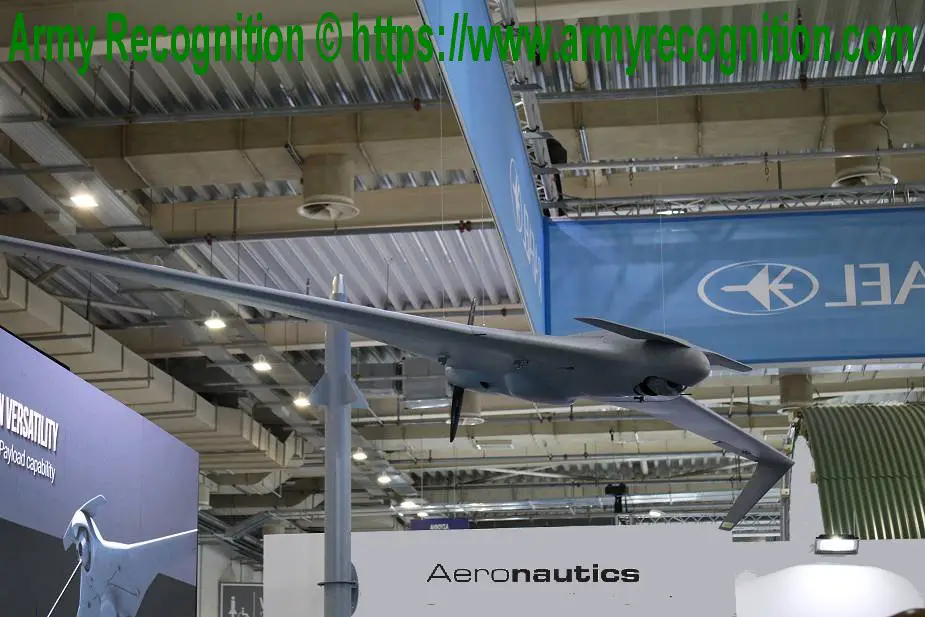Breaking news
DEFEA 2021: Aeronautics Group displays maritime Orbiter 4 UAS.
At DEFEA 2021, the International Defense Exhibition, the Israeli company Aeronautics Group, which is a leading provider of integrated turnkey solutions based on unmanned systems platforms, payloads, and communications for defense and HLS markets, displays Orbiter 4 Unmanned Aerial Systems (UAS).
 Orbiter 4 Unmanned Aerial Systems with maritime capabilites (Picture source: Army Recognition)
Orbiter 4 Unmanned Aerial Systems with maritime capabilites (Picture source: Army Recognition)
Slightly larger and almost twice heavier, Orbiter 4 uses a compact internal combustion engine to support 24-hour missions, flying up to 18,000 ft above ground. It has a much larger payload capacity, carrying 12 kg, compared to 5 kilograms of its electrically powered sibling. Both can carry multiple payloads, while Orbiter 4 can operate both payloads simultaneously, the T-STAMP-XR EO/IR in front and another load tucked in a fuselage bay. This can be a maritime search or synthetic aperture radar, electronic surveillance, or cellular interception payload.
With advanced image processing capabilities, automatic takeoff and recovery, and the ability to navigate with and without GPS and data link, Orbiter 4 delivers the capabilities of larger tactical platforms at a much smaller cost. Airstrip independent and operated by three personnel Orbiter 4 carries a small logistical footprint.
Maritime Capabilities
While all Orbiters can operate from the deck of naval vessels, including small boats with limited deck space, it is the Orbiter 4 that excels in this mission, for its versatile multi-payload capability of up to 12 kg and prolonged endurance of more than 24 hours, with an operational radius of 150 km. With its ease-of-use, low logistical footprint, and a small crew of 3 personnel, this runway-free aircraft suits all operational needs on land and at sea. Due to its open architecture and lean infrastructure demand, the Orbiter 4 can be specially adjusted for operation on any naval vessel, including small patrol boats.
The primary payload for this platform is Controp’s advanced STAMP-XR electro-optic payload. The T-STAMP-XR payload provides UAVs and aircraft with the image quality of large UAV payloads all in one miniature camera system. A secondary payload may be a Synthetic Aperture Radar (SAR). Among the different payloads area maritime patrol radar (MPR) and cellular interception modules, supporting naval surveillance, search and rescue operations over the land and sea, and satellite communications terminal. The cellular interception sensor allows Orbiter 4 to conduct ISR missions over different theaters exploiting the communication activity of the targets.
The T-STAMP-XR is a member of the STAMB STAbilized Miniature Payload family, which was developed to meet demanding Intelligence, Surveillance, Reconnaissance and Targeting (ISRT) missions on Small UAV (SUAV) platforms.
The STAMP systems provide maximum sensor range performance by using highly sensitive sensors, gyro-stabilization and unique video enhancement algorithms.
Among the maritime missions assumed by the Orbiter 4 are Deep-sea and coastal surveillance, Exclusive Economic Zone (EEZ), and Offshore facilities security. Other naval tasks support littoral and brown water operations, including ship self-defense, target acquisition for precision-guided weapons, gunfire direction, and BDA, similar to its role over land.
An exclusive economic zone (EEZ), as prescribed by the 1982 United Nations Convention on the Law of the Sea, is an area of the sea in which a sovereign state has special rights regarding the exploration and use of marine resources, including energy production from water and wind.


























